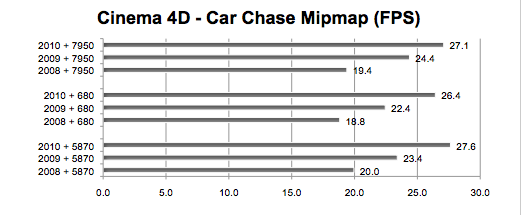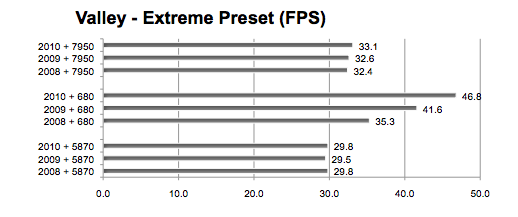Do the newest GPUs run faster on
the 2010 Mac Pro than on
the 2009 and 2008 Mac Pro?
Posted Friday, May 10th, 2013 by rob-ART morgan, mad scientist
We have stated in past articles that both the Sapphire Radeon HD 7950 Mac Edition and the EVGA GeForce GTX 680 Mac Edition are compatible with the 2008 Mac Pro and later. However, we received reports that these GPUs were running slower on the 2008 Mac Pro compared to our posted results for the 2010 Mac Pro. PowerMax.com provided us with a 2008 Mac Pro so we could find out for ourselves.
We tested both new GPUs in the 2008, 2009, 2010 Mac Pro using the same Velociraptor 1TB OS X 10.8.3 boot drive. We included the best 'legacy' GPU, the Radeon HD 5870 -- still available as a CTO option on new Mac Pros as well as in kit form.
GRAPH LEGEND
2010 + 7950 = Sapphire AMD Radeon HD 7950 in 2010 Mac Pro 3.33GHz 6-core
2009 + 7950 = Sapphire AMD Radeon HD 7950 in 2009 Mac Pro 2.93GHz 8-core
2008 + 7950 = Sapphire AMD Radeon HD 7950 in 2008 Mac Pro 3.0GHz 8-core
2010 + 680 = EVGA NVIDIA GeForce GTX 680 Mac Edition in 2010 Mac Pro 3.33GHz 6-core
2009 + 680 = EVGA NVIDIA GeForce GTX 680 Mac Edition in 2009 Mac Pro 2.93GHz 8-core
2008 + 680 = EVGA NVIDIA GeForce GTX 680 Mac Edition in 2008 Mac Pro 3.0GHz 8-core
2010 + 5870 = Factory AMD Radeon HD 5870 in 2010 Mac Pro 3.33GHz 6-core
2009 + 5870 = Factory AMD Radeon HD 5870 in 2009 Mac Pro 2.93GHz 8-core
2008 + 5870 = Factory AMD Radeon HD 5870 in 2008 Mac Pro 3.0GHz 8-core
All three Mac Pros had at least 16GB of main memory.
Motion 5 comes with various project templates. We use the 'Atmospheric - Open' 600 frame 1920x1080 template for our test. We time how long it takes to render the RAM Preview and then calculate the speed in frames per second. (LONGER means bar means FASTER AVERAGE frames per second.)

Cinema 4D OpenGL Animation -- We took the "Car Chase" from Cinebench 11.5, opened it in Cinema 4D, and played it back with max FPS set to 500 -- forcing the animation to run as fast as it could on a given GPU. OpenGL preferences were Texture Mode = Mipmap, Anti-Aliasing = 4, Maximum Transparency = 2, Maximum Lights = 5, Maximum Shadows = 2. Display setting was Gouraud Shading. (LONGER means bar means FASTER AVERAGE frames per second.)

DaVinci Resolve 9 adds speed and power to color grading of HD video. It uses the GPU to apply and playback using specified effects in real time -- no pre-rendering required. However, the more effect nodes created, the slower the playback.
The first graph features 8 clips (766 frames) of a 32 second 1920x1080 10-bit YUV 4:2:2 SDI 24fps video. We set the maximum playback framerate to 300 fps. We wanted to see how fast each GPU could playback with three nodes (including color correction and blur). Results are average frames per second. (LONGER means bar means FASTER AVERAGE frames per second.)

The second graph is using the popular Candle Test. (Not sure why it's called candle because the sample 4 second video clip features a parrot.) We set the playback rate to 300 fps to push it to playback the four blur nodes faster than the 24 fps target rate. (LONGER means bar means FASTER AVERAGE frames per second.)

Unigine's Valley "flies" through forest-covered valley surrounded by vast mountains. It's a birdŐs-eye view of 64 million meters of extremely detailed terrain down to every leaf and flower petal. It features advanced visual technologies: dynamic sky, volumetric clouds, sun shafts, DOF, ambient occlusion. (It is cross platform. For Windows users it is a test of DirectX.) We used Extreme preset: 1600x900 windowed resolution with 8x Anti-aliasing, Ultra Quality for Shaders and Textures, and with Occlusion, Refraction, and Volumetric Shadows enabled. (LONGER means bar means FASTER AVERAGE frames per second.)

INSIGHTS
1. In the case of the GTX 680 and Radeon 5870, Motion's performance improved as the Mac Pro got newer. The Radeon 7950, however, was stuck in low gear no matter what Mac Pro model we used.
2. Cinema 4D gained speed as we progressed from older to newer Mac Pro, but none of the three GPUs tested had a significant advantage over the others.
3. The 2008 Mac Pro displayed a definite handicap compared to the 2009 and 2010 in the two DaVinci Resolves tests.
4. The Valley benchmark ran faster on the newer Mac Pros when the GeForce GTX 680 was used. But both Radeon GPUs saw no improvement when installed in a newer Mac Pro.
OVERALL
Though our sample of tests is not exhaustive, the newest GPUs generally run faster in the newer Mac Pro towers. If and when a 2013 Mac Pro were to appear with Ivy Bridge Xeon and PCIe 3.0, it's very likely these new GPUs would perform even better with certain GPU intensive apps (if our experience with the 2012 iMac is any indication).
Oh, and by the way, we can confirm that both the Radeon HD 7950 Mac Edition and GeForce GTX 680 Mac Edition are fully compatible with the 2008 Mac Pro.
Comments? Suggestions? Email
, mad scientist.
Follow me on Twitter @barefeats